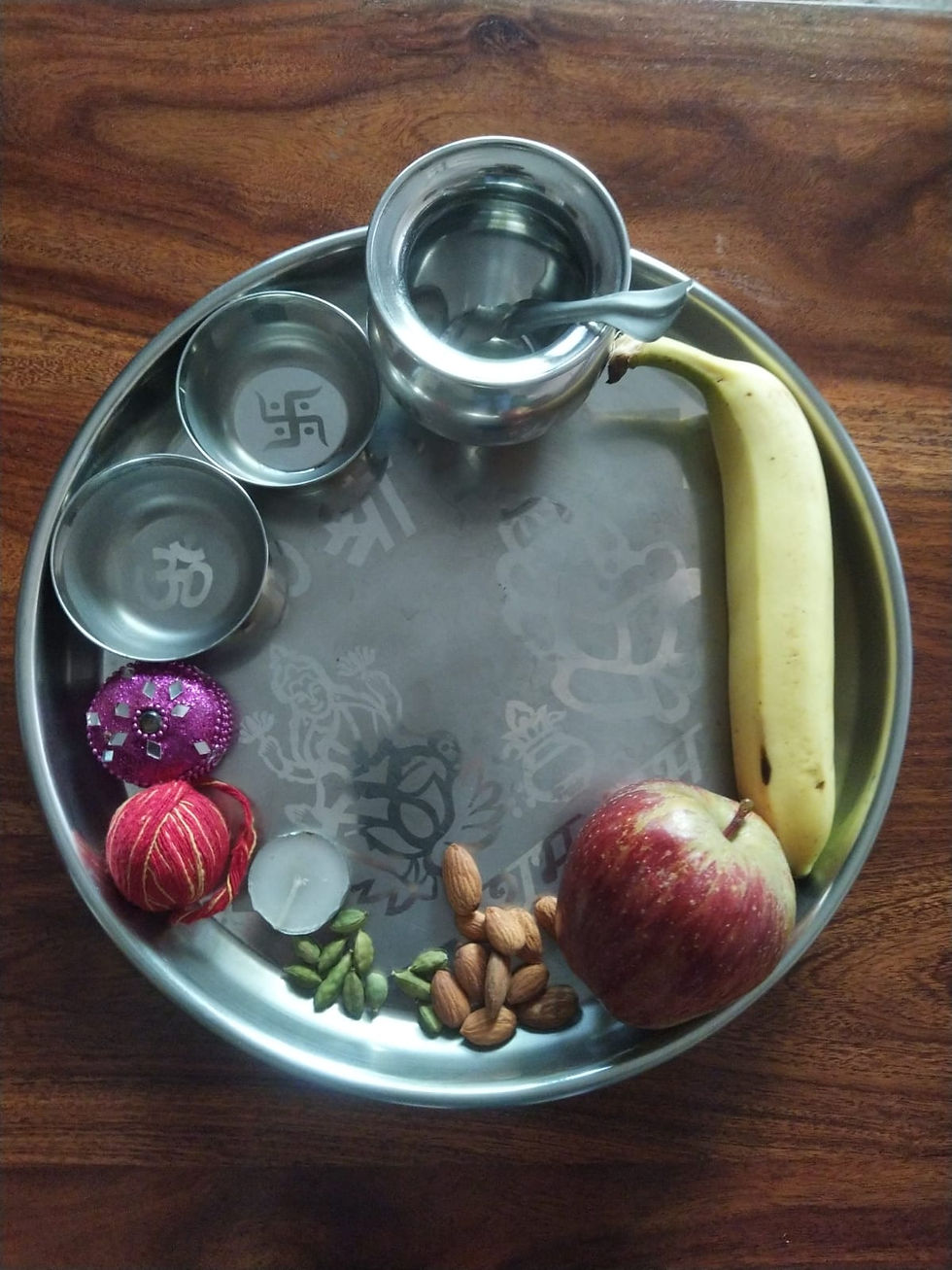Hartalika (हरतालिका) Teej (18.09.2023)-Rohit Kumar Parmar
- rohitkparmar
- Sep 18, 2023
- 4 min read

HartTeej01 Pooja ki thali
Hartalika (हरतालिका) Teej
(18.09.2023)
-Rohit Kumar Parmar [1]
Hartalika (हरतालिका) Teej is celebrated on Tritiya Tithi (third day) of Shukla Paksha (waxing or bright phase of the moon) in the Lunar month of Bhadrapada, corresponding to August/September of the Gregorian Calendar.
Hartalika Teej is the last of the three famous and special Teej [2] celebrated by women during Shravana/Bhadrapada months. Shravana/Bhadrapada months coincide with Varsha Ritu (वर्षा ऋतु) or monsoon, making them special. Hartalika Teej falls thirty days after the celebration of Hariyali Teej and a day before Ganesh Chaturthi.
Hartalika is a combination of Sanskrit words Harit (हरित) and Aalika (आलिका) which means "abduction" and (by a) "female friend", respectively.
According to the legend, Goddess Parvati performed penance on the banks of river Ganga, in order to get Lord Shiva as her husband. However, Lord Shiva being an ascetic, did not know about her wish.
Parvati’s father (Himalaya), was worried seeing her condition. So, on the suggestion of Rishi Narad, he promised her hand in marriage to Lord Vishnu. Goddess Parvati told her friend about this, who abducted her, to save her from the marriage to Lord Vishnu.
Goddess Parvati was taken to a dense forest where she performed penance and immersed herself in worship of Lord Shiva. Parvati made a Shivalinga from sand and silt of river Ganga and prayed to Lord Shiva.
Lord Shiva took notice of Parvati’s devotion and appeared before her in his divine form and agreed to marry her. From that moment, Goddess Parvati has been worshipped as Hartalika. Hartalika Teej is observed in memory of Parvati’s devotion and penance.
While women celebrate Haryali Teej and Kajari Teej by visiting their parent’s house. They, however, come back to their sasural (in-laws) to celebrate Hartalika Teej.
Women observe upvasa (fast) without taking any food or water (निर्जला). Like in several other festivals, unmarried girls also observe upvasa (fast) for finding a life partner of their choice, by seeking blessings of Gods/ Goddesses.

HartTeej02 Goddess Parvati praying to a Shivalinga
Women wear new red/green coloured saree or traditional dress, and do सोलह श्रृंगार (sixteen makeup/adornment steps), which include:
बिंदी (Bindi, a dot/small circle/other shapes, in the middle of the forehead)
सिंदूर (Sindoor, a red coloured powder on the maang, parting of the hair)
मांग टिकका (Maang tikka, a pendant/jewellery resting on a women’s forehead, hanging on a chain, partly over her head)
काजल (Kajal, a Black line on the eyelash as a makeup, also believed to protect from evil eye/spirits. Kajal, a natural preparation, helps keep the eyes cool and prevents it from infection)
कर्ण फूल (Karn Phool, Ear rings like chandbalis, jhumkas, hoops or studs)
मेहंदी (Mehendi, a paste prepared from the leaves of ‘Mendhika’ plant, and applied in attractive design/art forms, on hands, forearms and feet, overnight/for a long duration. It serves as a herbal cum medicinal dye giving a red colour.
नथ (Nath, Nose ring)
बाजुबंध (Bajubandh, Armband worn across upper arm)
चूड़ियाँ (Churiyan, Banglesof glass, stone, precious metals)
हाथफूल (Hathphool, Hand chain which connects the fingers and wrists)
हार (Haar, Necklace)
कमरबंध (Kamarbandh, Waistband)
पायल (Payal, Anklet)
बिछिया (Bichhiya, toe ring, usually worn on the second toe and made of silver)
इत्र (Attar, natural perfume made from flowers)
गजरा (Gajra, fresh flowers jasmine/marigold weaved as a string, tied on the hair)

HartTeej03 Designs of मेहंदी (Mehendi) on HartalikaTeej
On Hartalika Teej, gifts include सिंदूर (sindoor), बिंदि bindi, छुरियां (churiyan, bangles), traditional laheria dress, henna and sweets like घेवर, ghewar.

HartTeej04 Ghevar, a popular sweet
Women pray to Parvati and Shiva, remembering the wedding and staying up all night listening to prayers, bhajans, kirtans and kathas. Puja begins with holy offerings of flowers, fruits and sweets, and ladies listening to the Teej Katha in groups. Women gather at a nearby temple or garden for puja. They form a semi-circle with an idol of Goddess Parvati in the middle. Once the Puja is over, women make offerings to Goddess Parvati and seek her blessings. Women also light a दिया (diya, normally an earthen lamp), all night.
Hartalika Teej is celebrated in the states of Bihar, Chhattisgarh, Jharkhand, Madhya Pradesh, Maharashtra, Rajasthan, Uttarakhand, and Uttar Pradesh.
In Rajasthan, an idol of Parvati is taken out in a procession chanting and singing.
In Maharashtra, it is also known as Hartalika tritiya vrat, and women make idols with clay or river sand.
Hartalika Teej festival is celebrated as Gowri Habba in Andhra Pradesh, Karnataka, Telangana and Tamil Nadu. Gowri is the incarnation of Parvati. It is believed that on this day, Goddess Gowri like other married woman comes to her parents' house.
Haritalika Teej is also celebrated in Nepal.
[1] Author, Freelance, Indian Economic Service, Senior Economic Adviser (Retired), Government of India, Ministry of Consumer Affairs, Food and Public Distribution and former Adviser (P 4) UNDP, Yemen has in posts on his website (https://rohitkparmar.wixsite.com/site), LinkedIn (https://www.linkedin.com/in/rohit-kumar-parmar-841b4724) YouTube channel (https://youtube.com/@rohitkparmar), twitter (https://twitter.com/rohitkparmar?s=09), Facebook (https://www.facebook.com/rohit.parmar.5268750/), been writing/sharing varied topics and can be reached at rohitkparmar@yahoo.com. [2] A festival with Teej suffix suggests that it falls on the third day of the lunar month (either waxing or waning part).






Comments